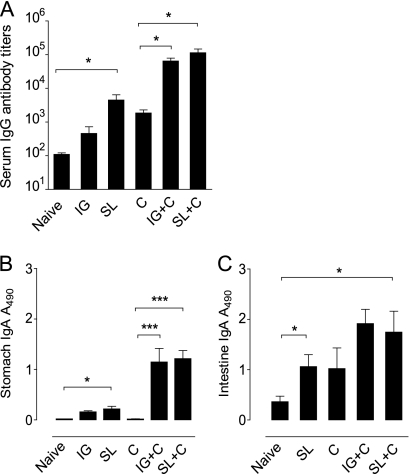FIG. 2.
Sublingual immunization induces H. pylori-specific serum antibody responses as well as a local H. pylori-specific IgA antibody response in the stomach mucosa both before and after challenge with live bacteria. Mice tested were as follows: age-matched unimmunized, uninfected C57BL/6 mice served as naïve controls; SL and IG are mice immunized by the SL or IG route and tested before challenge with H. pylori bacteria to study the effect of immunization alone on systemic and local antibody responses; C are unimmunized mice that were challenged with H. pylori and tested 4 weeks later; and SL+C and IG+C are mice that were immunized twice with H. pylori lysate antigens and CT via the sublingual (SL) or intragastric (IG) route, followed 1 week later by challenge with live H. pylori and tested 4 weeks after challenge. (A) Serum antibodies. H. pylori-specific serum IgG antibody titers in the groups of mice indicated were determined by ELISA. Data are representative of one of two independent experiments giving similar results. The bars represent mean + SEM antibody titers, *, P < 0.05. (B and C) IgA antibodies in stomachs and intestinal mucosae. Saponin extracts of stomach (B) and small intestinal (C) mucosa were analyzed for H. pylori-specific IgA antibodies by ELISA. Data represent mean (+SEM) absorbance values at 490 nm (A490) from one of two independent experiments giving similar results. *, P < 0.05; ***, P < 0.001.

